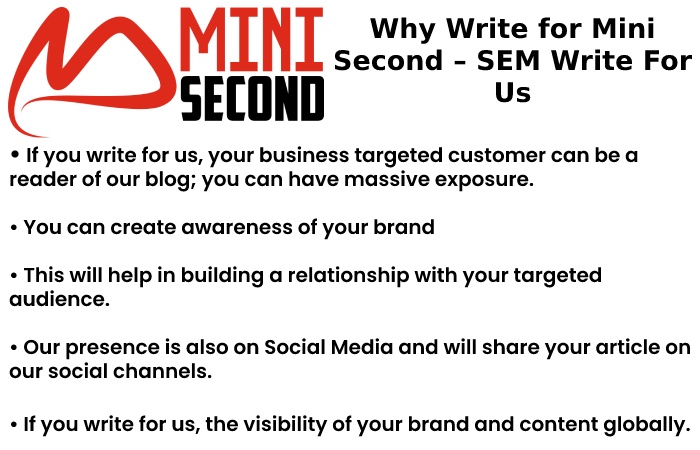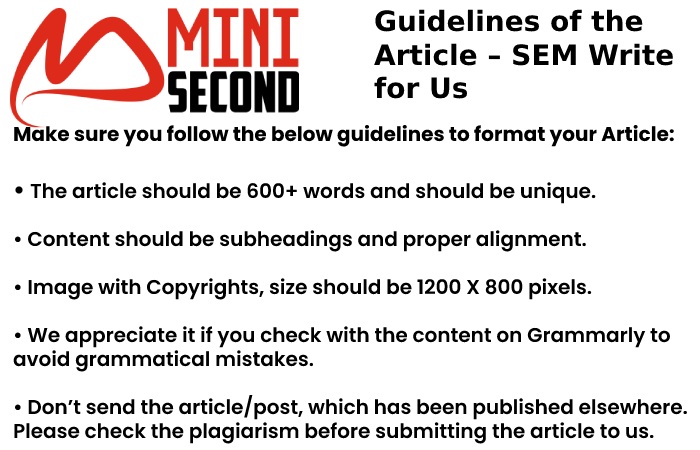SEM Write For Us – Sometimes, all digital terms seem to beacronyms, right? SEO, SEM, CPC, CPM… And it is that, at first glance, we would believe that these contain hidden meanings that only experts can understand.
Fortunately, that’s not true! An you are are about to verify it since you will know what SEM is, its advantages, disadvantages, and some key concepts you must learn t to implement and put your brand under the spotlight on the digital stage.
What is SEM?
The acronym SEM stands for: Search Engine Marketing. In theory, it contains all the actions aimed at positioning your brand in search engines, including SEO (optimizing pages to obtain a better position in the organic results of search engines).
SEM refers only to paid ad movements on search engines like Google, Bing, and Yahoo.
SEM helps improve brand visibility and quickly directly qualify audiences to your website (people with specific characteristics).
For practical purposes, from now on, we will continue to refer to SEM as a paid advertising tool
Advantages of EMS
- It works faster than SEO, giving you quick and medium-term results. But on the other hand, SEO works in the long run (although it still needs to be implemented).
- The SEM allows you to segment and bring to your website only the public that interests you.
- It helps to upsurge the visibility of your brand.
- SEM tools like Google Adwords allow you to drive and measure conversions, monitor your campaigns in real-time, and make adjustments.
- You can advertise with small budgets. You decide how much you want to invest each day and how much you want to pay for each click on your ad.
- In addition to appearing in search engine results, you can do it on websites with some relationship with your brand.
Disadvantages of EMS
- Unlike SEO, SEM is an interruptive practice since it provides information not requested by the user.
- Those who use ad blockers may not see your content.
- It only works as lo g as you pay. That is why you must define very well how much you will invest.
- Many brands are c petting for the exact keywords. This makes costs increase, and it is increasingly difficult to position yourself.
SEM and SEO: how are they different?
Expenses to position in search engines
Up to this point in the reading, we understand that SEM is the publications that appear in the first positions of the search engines and in which the advertiser pays for each click it receives from the users.
On the other hand, SEO SEO goes more than the work done on the website to optimize its content and have greater visibility in search engines.
speed of results
One of the chief differences is the time the results can be appreciated. Being a paid tool, SEM generates results immediately.
Of course, if you stop paying, you stop seeing those strategic changes. But on the ther hand, when you apply SEO, the strategy begins to give results in a more extended period.
Performance predictability
The way to control these tools is also different.
With SEM, it is easier to establish investment guidelines, hang campaigns or take them out of circulation at the moment we decide because we are paying to have control.
With SEO, you can control the strategy you use and the content you generate, but you cannot accurately measure if you are on the right track.
breadth of investment
The investment expenses are also different in terms of these two positioning tools.
As we have already said, SEM is a paid tool; the user has to invest in the search engine to be able to generate their campaigns.
On the other hand, SEO SEO does not require financial investment but creative investment since good positioning is achieved naturally and thanks to search engine algorithms.
Search engine placement
These two strategies are also differentiated by their location in search engines.
Publications with an SEM strategy are generally published at the top of the portal or on its right side and are often identified as advertisements.
As for SEO posts, they appear in the central area of the page.
Managing the keywords
The keywords and the published content also vary depending on the Digital Marketing tool used.
SEM positioning is much simpler because there are no limits to choosing t the keywords to use,, and in terms of content, it must be more precise and relate to the chosen keywords and a structure that denotes sales intention.
In the case of SEO, there are limitations in terms of the number of keywords to choose to achieve good positioning,. In terms of content, it is essential to have quality materi l that is interesting and attractive to the reader.
12 essential concepts o make an SEM strategy
1. Adwords
It is a Google tool that allows you to do paid advertiscan online. You can create ads to appear in Google seweb pagesb pages that are related to your keywords.
2. Keyword
They are the words and phrases written in the search engine when performing a search.
The search engine returns the results most similar to that eyword, so you must choose very well what are the terms with which you want t be found. Help yourself with tools to find keywords like the Google Keyword Planner.
3. Ad Group
They are several ads that respond to the same group of keywords.
For example, if you own a fashion store and want to promote a new lothing line, you can choose multiple keywords and create multiple ads for this purpose. This allows y u to analyze which ad is more effective.
4. Campaign
Campaigns are made up of ad groups. Continuing with the example of the fashion store, a campaign wo ld be made up of an ad group for dresses, another for pants, and another for blouses.
5. Search network
These are the places where your ads will appear.
This can be at the top or right of the results page, on Google Sites (Google Play, Google Shoppi g, and Google Maps), or on Google’s display network search partners, such as YouTube.
6. Impressions
It is the number of times your ads are shown. Every time your ad shows up in Google results or on another site on the search netwo k, it’s considered an impression.
7. Clicks
Number of times your ad banners are clicked. These let you know if a particular ad is attractive to those who see it.
8. CTR
It stands for ClicEach of your ads receivesough Rate. Moreover, it is the our ads receives concerning the number of impresses on.
It is calculated as a percentage and helps measure the impact of your campaigns.
9. Daily budget
It is the maximum value that you are willing g to pay each day. It depends solely on you.
10. CPC Bids
CPC stands for Cost Per Click. It is the average value that you are eager to pay for each click on your ads. You can define a maximum CPC to avoid going over your daily budget.
You have the option to choose between manual or automatic CPC bidding.
In the latter case, Google adjusts the maximum CPC for you to get the most clicks possible from your daily budget.
We recom end focusing on a CPC bid type if you’re observing to drive traffic to your website.
1 . CPM Bids
CPM stands for Cost Per Thousand, that is, the cost per thousand impressions. In this case, you do not pay per click, but rather for the number of times your ad appears.
If your trategy is more oriented to generate reach than traffic, this is the option for you.
12. Quality level
It’s an estimate that Google makes of the quality of your ads, landing page, and keywords.
Higher quality means lower prices and better ad position.
How to make a SEM strategy?
Now that you know how the SEM tool works, its advantages, and how it differs from other practices such as SEO, it is worthwhile for us to see how to make an effective SEM strategy.
Before starting your SEM campaign you must determine very well the following the following:
- objectives (reach, traffic, conversions…),
- target audience, location, search intentions, etc..,
- keywords,
- budget,
- landing page of your ads,
- competence,
- campaigns and ad groups,
- ad content.
Once you have all the nary data, then you can start designing the different advertisements that wiltobe essential in your campaign.
In this sense, it is recommended that you take all the time necessary to create a campaign that has attractive ontent, that invites the user toclick on i,t and abov,, providesvides information of interest.
At this point, in addition to selecting good content, you will have to focus your attention on the distribution of keywords that will help obtain the desired results as the case may be.
Another point that you must tyou must consider, especially whenith this digital marketing tool, is the continuous monitoring of your campaigns.
Remember that you are making a monetary investment, with which it is convenient to make the necessary adjustments so that your campaign is effective and that at the same time you do not waste your investment.
It is true that with digital advertising , the possibilities for a company to grow are greater, but you have to start small, try and discard what does not work to reinforce, mainly your name and your presence.
In this sense, it is recommended that you pay special attention to extensions that help enrich your ads and of course their visibility when a user performs a search.
For example: add the location and contact numbe of your business, links to different publications on your website that you consider to be of interest. Also choose to rotate your ads more otou can get more clicks.
How to combine SEM and SEO strategies?
At this point, it is very clear that both strategies, both SEM and SEO, are essential to improve the online presence of your brand and appear at the top of search engines.
The s ccessful integration of SEO and SEM means that they must be aligned with the same goals and objectives. Furthermore, since SEO will take time to build online visibilityneedwe ne d to complement it with SEM.
Timing will play a crucial role in creating an impactful overall marketing strategy.
1. Use the rig t keywords
Anything that involves search engine strategies will require a robust implementation of keyword research. SinIn addition, sincee market of each establishment is different, it is necessary to evaluate which terms will gen positiveitive growth for the business.
WheRRememberd develop a buyer persona. I when searching for good keywordst’s an ideal when searching for good keywords representation of the type of market you want to serve, defined by their age, gender, occupation, location, and other identifiable qualities.
You can develop several buyer personas to segment different products and services. Once you have your target audience in mind, you will havbetter understandderstandst of relevant keywords to target.
It is also helpful to research the use of competitor keywords asreference c to reinforce your own.Generallye, go for long tail keywords and local terms to target a specific market.
2. Integrate your keywords to SEO and SEM
With your complete list of target keywords , now implement them for on-site optimization and SEM ads.
Remember to follow proper SEO practices and aoververlo ding your site’s keyword density.
Be purposeful when placing them in specific sections, especially for CTA butons . You can also introduce backlinks to proven keywords to increase internal link strength within the website.
3. Maintain and readjust your marketing strategies
Keep in mind that SEO and SEM strategies should never remain static unless it gives you “dece t” numbers.
The Digital Marketing landscape is continually changing, so brands and consumers must adapt accordingly. For this reason, the incorporation of SEO and SEM strategy must grow and develop over the years.
Constantly monitoring the metrics of the sites will give you an idea of whether they have effec ive conversion rates .
If not, you will need to reevaluate your strategies and find weaknesses in the sales funnel . However, stagnant figures can also be dangerous if they are not changed.
It is for this For this reason,ys strive for an upward trend in all marketing moves. Remember that complacency is an easy way to lose your way to success.
Conclution
Before starting your SEM campaign you must determine very well:
- objectives (reach, traffic, conversions…),
- target audience, location, etc,
- keywords,
- budget,the
- landing page of your ads, campaign,s and ad groups,
- ad content.
Remember that, although effectiv , SEM campaigns must go hand in hand with SEO. So do not forget to optimize your pages by providing quality content. That combination will be key for your brand to shine on the digital marketing stage !

Likewise, You can submit your articles at contact@minisecond.com
How to Submit Your SEM Articles (SEM Write For Us)?
That is to say, To submit your article at www.minisecond.com, mail us at contact@minisecond.com
Why Write for Mini Second – SEM Write For Us
SEM Write For Us
That is to say, here at Mini Second, we publish well-researched, informative, and unique articles. In addition, we also cover reports related to:
electron microscope
electrons
atoms
topography
raster scan
intensity
secondary electrons
Everhart–Thornley detector
vacuum
cryogenic
microscope
electrons
photons
resolving power
light microscopes
Guidelines of the Article – SEM Write For Us
Search Terms Related to [SEM Write For Us]
write for us digital marketing
social media marketing + “write for us”
[write for us + business]
[write for us technology]
[write for us eCommerce]
SEO write for us
advertising + write for us
keyword write for us
marketing”+“write for us”
mobile SEO write for us
write for us + business
“write for us” + social media
“advertising” “write for us…”
write for us eCommerce
write for us web design
saas write for us
Related Pages
Write for Us Chatbots
Write For Us Teeth Whitening
Hair Product Guest Post
Motorcycle Insurance Write For Us
Diet And Nutrition Write for Us
Stamps Write For Us
Glowing Skin Write for Us
Write for Us K
Web Design Write For Us
Market Write For Us


